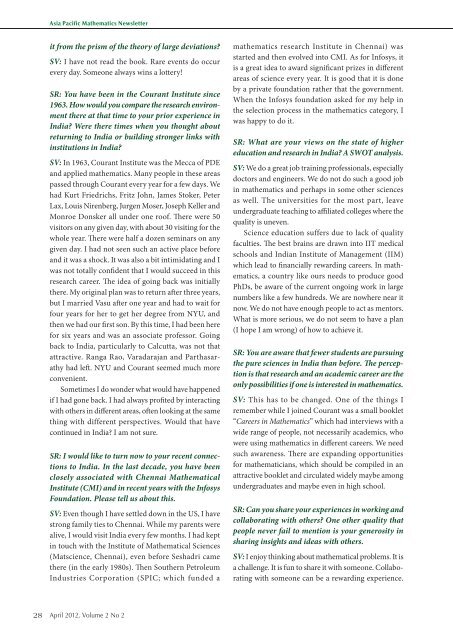Mathematics Newsletter
Mathematics Newsletter
Mathematics Newsletter
You also want an ePaper? Increase the reach of your titles
YUMPU automatically turns print PDFs into web optimized ePapers that Google loves.
28<br />
Asia Pacific <strong>Mathematics</strong> <strong>Newsletter</strong><br />
it from the prism of the theory of large deviations?<br />
SV: I have not read the book. Rare events do occur<br />
every day. Someone always wins a lottery!<br />
SR: You have been in the Courant Institute since<br />
1963. How would you compare the research environment<br />
there at that time to your prior experience in<br />
India? Were there times when you thought about<br />
returning to India or building stronger links with<br />
institutions in India?<br />
SV: In 1963, Courant Institute was the Mecca of PDE<br />
and applied mathematics. Many people in these areas<br />
passed through Courant every year for a few days. We<br />
had Kurt Friedrichs, Fritz John, James Stoker, Peter<br />
Lax, Louis Nirenberg, Jurgen Moser, Joseph Keller and<br />
Monroe Donsker all under one roof. There were 50<br />
visitors on any given day, with about 30 visiting for the<br />
whole year. There were half a dozen seminars on any<br />
given day. I had not seen such an active place before<br />
and it was a shock. It was also a bit intimidating and I<br />
was not totally confident that I would succeed in this<br />
research career. The idea of going back was initially<br />
there. My original plan was to return after three years,<br />
but I married Vasu after one year and had to wait for<br />
four years for her to get her degree from NYU, and<br />
then we had our first son. By this time, I had been here<br />
for six years and was an associate professor. Going<br />
back to India, particularly to Calcutta, was not that<br />
attractive. Ranga Rao, Varadarajan and Parthasarathy<br />
had left. NYU and Courant seemed much more<br />
convenient.<br />
Sometimes I do wonder what would have happened<br />
if I had gone back. I had always profited by interacting<br />
with others in different areas, often looking at the same<br />
thing with different perspectives. Would that have<br />
continued in India? I am not sure.<br />
SR: I would like to turn now to your recent connections<br />
to India. In the last decade, you have been<br />
closely associated with Chennai Mathematical<br />
Institute (CMI) and in recent years with the Infosys<br />
Foundation. Please tell us about this.<br />
SV: Even though I have settled down in the US, I have<br />
strong family ties to Chennai. While my parents were<br />
alive, I would visit India every few months. I had kept<br />
in touch with the Institute of Mathematical Sciences<br />
(Matscience, Chennai), even before Seshadri came<br />
there (in the early 1980s). Then Southern Petroleum<br />
Industries Corporation (SPIC; which funded a<br />
April 2012, Volume 2 No 2<br />
mathematics research Institute in Chennai) was<br />
started and then evolved into CMI. As for Infosys, it<br />
is a great idea to award significant prizes in different<br />
areas of science every year. It is good that it is done<br />
by a private foundation rather that the government.<br />
When the Infosys foundation asked for my help in<br />
the selection process in the mathematics category, I<br />
was happy to do it.<br />
SR: What are your views on the state of higher<br />
education and research in India? A SWOT analysis.<br />
SV: We do a great job training professionals, especially<br />
doctors and engineers. We do not do such a good job<br />
in mathematics and perhaps in some other sciences<br />
as well. The universities for the most part, leave<br />
undergraduate teaching to affiliated colleges where the<br />
quality is uneven.<br />
Science education suffers due to lack of quality<br />
faculties. The best brains are drawn into IIT medical<br />
schools and Indian Institute of Management (IIM)<br />
which lead to financially rewarding careers. In mathematics,<br />
a country like ours needs to produce good<br />
PhDs, be aware of the current ongoing work in large<br />
numbers like a few hundreds. We are nowhere near it<br />
now. We do not have enough people to act as mentors.<br />
What is more serious, we do not seem to have a plan<br />
(I hope I am wrong) of how to achieve it.<br />
SR: You are aware that fewer students are pursuing<br />
the pure sciences in India than before. The perception<br />
is that research and an academic career are the<br />
only possibilities if one is interested in mathematics.<br />
SV: This has to be changed. One of the things I<br />
remember while I joined Courant was a small booklet<br />
“Careers in <strong>Mathematics</strong>” which had interviews with a<br />
wide range of people, not necessarily academics, who<br />
were using mathematics in different careers. We need<br />
such awareness. There are expanding opportunities<br />
for mathematicians, which should be compiled in an<br />
attractive booklet and circulated widely maybe among<br />
undergraduates and maybe even in high school.<br />
SR: Can you share your experiences in working and<br />
collaborating with others? One other quality that<br />
people never fail to mention is your generosity in<br />
sharing insights and ideas with others.<br />
SV: I enjoy thinking about mathematical problems. It is<br />
a challenge. It is fun to share it with someone. Collaborating<br />
with someone can be a rewarding experience.


